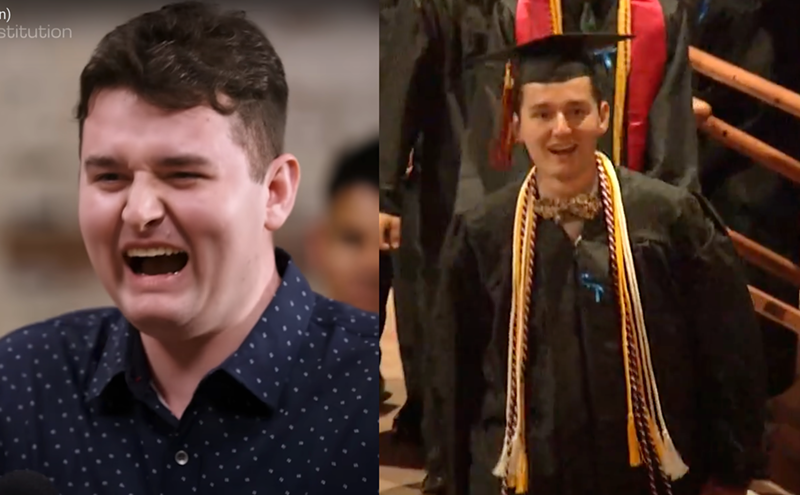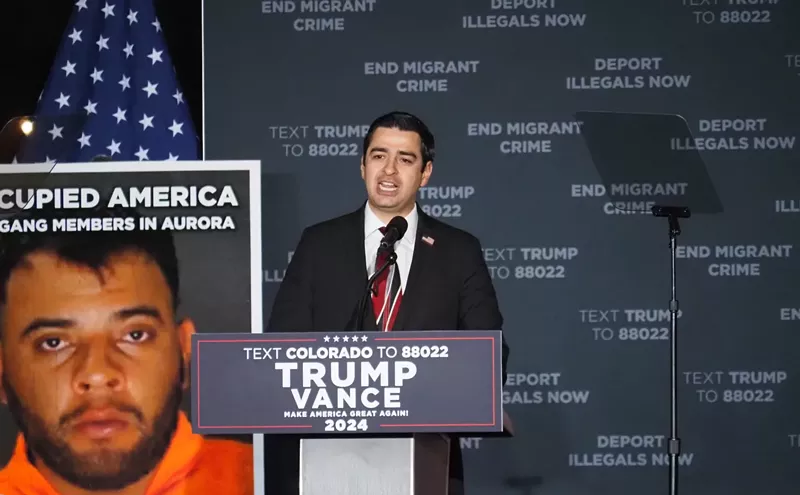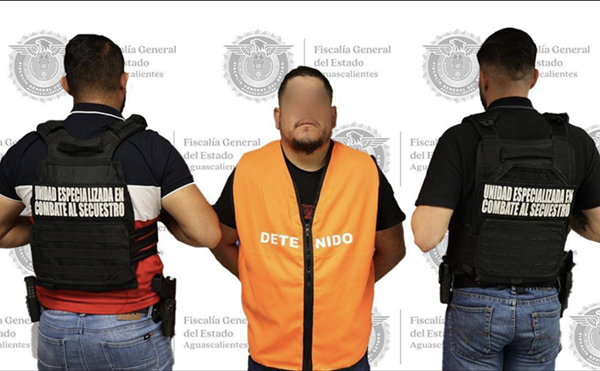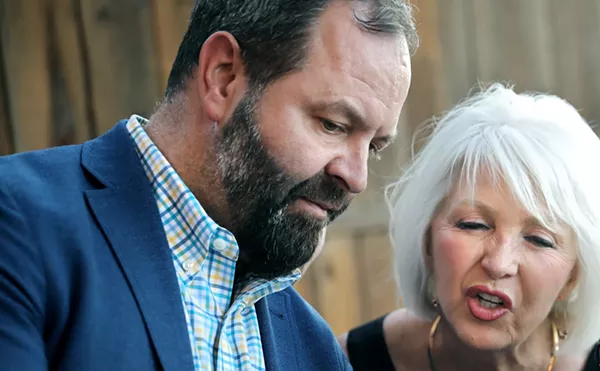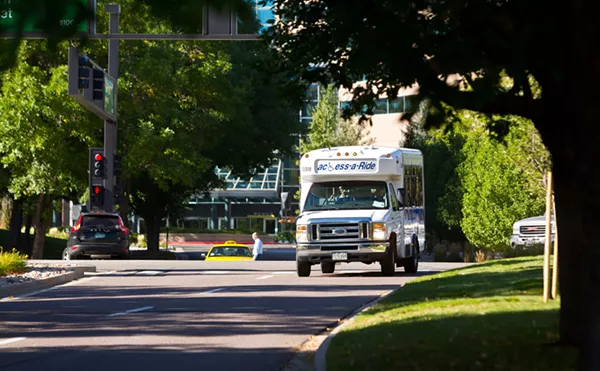This is our thirtieth Best of Denver edition. Over the years, we've given at least 15,000 awards. Some of the categories — Best Mobile Hot Tub? — have disappeared, reflecting how trends come and go in a boom-and-bust-and-boom town; other honorees, such as the Winter Park Ski Train, simply reached the end of the line. But some winners — many of them multiple award winners — are still around, and still deserving of celebration. They've become Colorado Classics.
1984: John Elway. Our very first Best of Denver gave a prize to a newcomer to town: the Denver Broncos' brand-new quarterback, who'd had a very discouraging season after gracing the cover of Westword during his first days at training camp in 1983. Even so, we made a winning play and gave John Elway the Best Future award. "A Hall of Famer, for sure," we predicted. Today Elway is making winning plays from the Broncos' head office and continuing to score fans with his eponymous restaurant chain.
1985: My Brother's Bar. The oil bust had hit, but there was plenty of grease on the grill that cooked up the town's Best Cheeseburger at My Brother's Bar, located on the dark, dusty edge of the Platte Valley in a building that had first opened as a saloon a century ago and remained the city's longest-operating bar through many owners and names. In 1970, the Karagas brothers bought the place, which went for a couple of years without a name and without much money. "It just dawned on us one day that we should call it My Brother's Bar," recalls Jim Karagas, who today still greets guests at My Brother's.
1986: Mayan Theatre. Just when demolition seemed imminent for the then-53-year-old movie palace, a landmark on down-and-out Broadway, the feisty Friends of the Mayan stepped up in late 1985 and saved the structure, preserving the historic facade and making it the Best Building Saved in the Nick of Time. Today the Mayan remains a true treasure, a piece of art that shows art (and also serves cocktails!) on three screens.
1987: Benny's Cantina. Benny Armas, a veteran of numerous kitchens around town (he got his start as a dishwasher at the Blue Bonnet), finally opened a place he could call his own in 1987, when it won Best Taco. In the 25 years since, Armas has expanded Benny's numerous times, finally moving to a spot at 301 East Seventh Avenue, where Benny's Restaurant & Tequila Bar still packs them in today, serving pitchers of potent margs and some of the town's hottest green chile — another Colorado classic.
1988: Chuck Morris. In 1988, Chuck Morris Entertainment was honored as Best Music-Biz Manager on a Roll. And 25 years later — the last six with Anschutz Entertainment Group — Morris just keeps rolling along, with bigger and better plans every year. And the accolades keep rolling in, too: In May, Morris will be honored as the subject of an original play at Curious Theatre Company.
1989: Wynkoop Brewing Company. In the fall of 1988, a geeky, unemployed geologist and a handful of partners with just a smidge more experience opened the town's first brewpub, the Wynkoop Brewing Company, set in a ramshackle part of the city that had just been dubbed the Lower Downtown Denver Historic District. And the rest is, indeed, history. The brewpub industry exploded in Denver, and the Wynkoop, which scored Best Restaurant Art in 1989, with many more Bests to follow, keeps winning awards. As for that unemployed geologist, he left the restaurant business to make a dark-horse run for mayor — and today John Hickenlooper is governor of Colorado.
1990: Barry Fey. Already a legend as this town's foremost rock empresario, Barry Fey gained a new title in 1990: Best Classical Godfather. In 1989, when the Denver Symphony Orchestra was bankrupt and its board was ready to disband, Fey stepped in, rallied the city and saved the symphony. As thanks, the newly formed Colorado Symphony Orchestra put a plaque honoring Fey in Boettcher Concert Hall — a plaque that had disappeared by the time the symphony went through its next big crisis. But the CSO's new managers reissued it last year.
1991: Mercury Cafe. Marilyn Megenity has kept Denver cooking since back in the '70s, when she opened her first spot in Indian Hills; the next fifteen years were a movable feast as she moved her combo restaurant/club around Denver. But in 1990, Megenity finally bought a Victorian building at 2199 California Street that in 1991 was named the Best Club That's Returned From the Dead. Today the Mercury Cafe remains the center for an incredibly lively, entertaining and, most important, enlightened cultural scene.
1992: Lake Steam Baths. Denver's Jewish community was once centered on West Colfax Avenue, and few vestiges of that neighborhood remain today. But Lake Steam Baths, which was already 65 years old when it won our Best Massage Deal in 1992, continues to be one of this town's most liquid assets, soothing the soul through traditional spritz, exfoliating scrubs — and deli-style meals. There are different nights reserved for women and men — and, yes, you have to get naked.
1993: Chubby Burger Drive Inn. Back in 1967, Stella Cordova was working as a cook at the Chubby Burger Drive Inn when the owner said he wanted to get out of the business; he gave Stella — who was making 85 cents an hour — a great deal so that she could buy it. She kept the name but changed the menu to feature the Mexican food she'd grown up with, and Chubby's quickly became known for its hot, hot green chile. Soon, assorted offspring — Stella had ten children — and their offspring began opening their own variations on Chubby's, with or without Stella's okay. That proliferation prompted us to name her original spot on West 38th Avenue the Best Chubby's in 1993. Stella Cordova passed away in 2008, but her restaurant, a true Colorado classic, continues to cook.
1994: "America, Why I Love Her." By 1994, Denver International Airport had already missed one opening date, and it would blow through two more. But one DIA feature was right on time, and right on target: Gary Sweeney's "America, Why I Love Her," our Best New Public Art that year. DIA's budget included $7.5 million for art, and although a few pieces flopped and one — Luis Jiménez's "Mustang" — wouldn't be delivered for another fourteen years, Sweeney's "America: Why I Love Her," which celebrated more than 200 odd tourist attractions on a large wooden map, quickly became a beloved city landmark. Sadly, when Continental pulled its planned hub from the finally open airport, Sweeney, a baggage handler, wound up relocating to San Antonio.
1995: Denver Central Library. Soon after Denver was founded, a library sprang up in the frontier town. Over the years, it kept moving into bigger and better spaces — including a Carnegie-funded building in 1909, then across Civic Center Park to a Burnham Hoyt-designed structure in 1956. When Denver's rapacious readers spilled out of that spot, rather than move on, the DPL decided to add on — and how. Its Michael Graves extension, which was named our Best New Building in 1995, is a riot of shapes and colors that continue to remind us that reading is a real pleasure — and a library a true civic treasure.
1996: Phil Bender and Pirate. Much of the energy in Denver's art scene has always come up from underground. By 1996, what started as Pirate: An Art Oasis was well into its second decade — and a certain level of respectability, with a remodeling of the current Pirate gallery on Navajo Street. That's when we named founder Phil Bender the Best Famous Artist Whose Time Has Come — but more than a dozen years would pass before this self-professed Famous Artist was honored with a Mayor's Award for the Arts. Bender's own work specializes in multiples — but he's one of a kind.
1997: Tattered Cover. You could fill a book with all the Best of Denver awards that various Tattered Cover locations have won over the years. And in honor of that, in 1997 we created a special award: Best Tattered Cover. The LoDo store won. Today it's one of three Tattered Covers; the others are at the Lowenstein Complex on Colfax and in Highlands Ranch. The author of this long-running success story remains owner Joyce Meskis, but she wants to give credit where it's due. "The Tattered Cover would be nothing without the readers behind it — that's the untold story," she told us a few years ago. "Denver is a terrific book town, and we have been very fortunate."
1998: Trey Parker and Matt Stone. Twenty years ago, two University of Colorado film students decided to make a musical about Alferd Packer, Colorado's legendary cannibal. Their careers took off so fast that they never managed to get college degrees. But they've collected plenty of awards for their subsequent creations, including South Park, the long-running Comedy Central cartoon series with its foul-mouthed Colorado kids that earned them the Best Local Boys Made Good in 1998, and The Book of Mormon, the Broadway musical now collecting raves as it travels the country.
1999: Antique Row. Broadway, heading south from downtown, was once known as the Miracle Mile. By the end of the twentieth century, though, it had seen a major decline that has only reversed itself in the last decade. But one stretch of Broadway has remained a winner for the past thirty years: The dozen blocks south of I-25 known as Antique Row, our winner of the Best Street for an Out-of-Town Packrat in 1999. And it still is today, as dozens of independent businesses along the strip continue to mine the past for a prosperous future.
2000: El Chapultepec. The music never ends at El Chapultepec, the jazz club that opened in the '30s at 20th and Market streets, long before that area got the hip nickname LoDo, longer still before Coors Field brought new life to the neighborhood. Over the years, El Chapultepec gained a legendary reputation as a jazz mecca not just in Denver, but around the world. Although owner Jerry Kranz passed away a decade after El Chapultepec won Best Jazz Club honors, again, in 2000, the bands play on.
2001: Oxford Hotel. More than a century ago, sophisticated travelers would head directly from Union Station to the lovely Oxford Hotel — a path they'll be following again when Union Station reopens as a multi-modal transportation hub next year. And when they check in, they can check out many of the Oxford's historic features, ranging from the Cruise Room, a bar modeled after a lounge on the Queen Mary that opened the day after Prohibition ended, to the country's most impressive men's room, with magnificent marble urinals where Bat Masterson is rumored to have emptied his, er, weapon — and which earned the hotel Best Rest Stop in 2001.
2002: Rockmount Ranch Wear. Just down the street from the Oxford is Rockmount Ranch Wear, the business that Jack A. Weil founded when he invented the snap-button Western shirt. For decades — and we mean decades — the Weil family ran a wholesale business out of this old warehouse. But in 2002, the Weil family — Jack A., son Jack B. and grandson Steve — opened a retail store in their building, creating the Best-Looking Place to Dress Like a Cowboy. Both Jack A. and Jack B. have passed on, but Rockmount Ranch Wear keeps rocking.
2003: Confluence Park. Denver got its start close to Confluence Park, when gold was discovered nearby. Today this park at the confluence of the South Platte River and Cherry Creek — named our Best Spot on the Cherry Creek Bike Path in 2003 — continues to be solid gold for recreation-loving Denverites. And on hot summer days, when city-dwellers flock to this always-improving park, it rates another award: Best Beach.
2004: Chipotle. Back in 1993, Steve Ells decided to import a concept he'd encountered in the Mission District of San Francisco to Denver: big burritos. He opened his first Chipotle near the University of Denver, his alma mater, that year — and the business was quickly on a roll. It's collected numerous awards over the years, including Best Burrito in 2004, but Denver isn't the only spot that appreciates Chipotle. Today the company has more than 1,000 restaurants around the world — including the original, still going strong on East Evans Avenue.
2005: La Fiesta. Colorado has more culinary claims to fame than Chipotle. It's also known for its green chile, which became thicker and meatier than the green chile of New Mexico as it headed north. Since the late 1950s, when the Herrera family turned an old Safeway into a Mexican restaurant, it's been cooking up big batches of Colorado-style green chile — which won a Best of Denver award in 2005, one of many honors for this spot. Today La Fiesta is only open for lunch on weekdays — when you're likely to find tables filled with everyone from Colorado Supreme Court justices to music promoters slurping up bowls of green.
2006: PeaceJam. We couldn't make up a story this outlandish. In the mid-' 90s, former society scribe (for 87 days), artist and car-parker Ivan Suvanjieff decided he needed to do something to convince kids to stop the violence, and so he started PeaceJam. Today he and partner Dawn Engle run a global operation out of Arvada that features a board of Nobel Peace Prize winners and dozens of events around the world every year for kids. In the process, they collected a few Nobel Peace Prize nominations themselves, as well as an award for Best Denver Ambassadors in 2006.
2007: Buffalo Bill Museum and Grave. A century ago, Denver started collecting open space in the mountains. As a result, the city today has two dozen mountain parks that hold two buffalo herds, a ski resort and the Buffalo Bill Museum and Grave, a spot on Lookout Mountain where the view is so spectacular that you can easily believe the story that world traveler William Cody pronounced it precisely the spot where he'd like to be laid to rest for all eternity. It also has a great gift shop, which earned the Buffalo Bill memorial Best Souvenirs by a Gravesite in 2007.
2008: Racines. For close to three decades, in two locations, Racines has been Denver's place to see and be seen. In 2008, it won yet another award for Best Power Breakfast — an honor it proved it deserved during the Democratic National Convention, when both national and local power brokers grabbed tables alongside Denver's important cultural leaders, media mavens and the regular customers who pack the place every day. Remember, your mother always said that breakfast was the most important meal of the day.
2009: Red Rocks Amphitheatre. The Great Depression of the '30s wasn't all bad news. Thanks to the Civilian Conservation Corps, the Denver area reaped the benefits of several federal projects, including Red Rocks Amphitheatre. Hundreds of New Deal laborers worked to create a stage and seating in this stunning setting; the amphitheatre, finished in 1941 and improved periodically since, is legendary with artists around the world, earning the venue global praise — and our Best Souvenir of the Depression in 2009.
2010: 16th Street Mall. The 16th Street Mall celebrated its thirtieth birthday in 2012 — but long before that, it was Denver's Best Place to People-Watch, an honor we awarded, again, in 2010. Thanks to hard work by the Downtown Denver Partnership, 16th Street isn't just a great place to watch people these days: It's also an increasingly good place to shop, with specialty stores — both national and local — replacing the old department stores that lined 16th Street when the mall was still an urban-development dream.
2011: George Karl. The Denver Nuggets coach had beaten cancer for the second time when he won our Best Professional Coach award in 2011, right after he'd let Carmelo Anthony go and signed a new contract. And today? Last time we looked, the Nuggets were on a fifteen-game winning streak.
2012: "Mustang." Blucifer, as the 32-foot-tall blue stallion outside of Denver International Airport came to be known, was many times over budget and a dozen years past due when it killed its creator, Luis Jiménez, who bled to death after the still-under-construction sculpture fell on him. But it wasn't until the completed "Mustang" appeared outside of DIA in 2008 that the manure really hit the fan, with outraged Denverites demanding that the piece be removed. The city refused, pointing to a policy that requires public art to be in place for five years before Denver will consider removing it. And a funny thing happened on the way to 2013: People grew fond of "Mustang," which won our Best Public Art award in 2012. And this past February, when the sculpture passed the five-year mark, no one suggested that the city send the horse out to pasture.
2013: John Hickenlooper. After a decade in politics, the last twelve months have been very tough for John Hickenlooper, starting with the devastating North Fork fire and continuing with blazes across the state, including fatal infernos outside of Fort Collins and Colorado Springs. Then came the shootings in Aurora and the recent murder of Tom Clements, director of the Colorado Department of Corrections. Through it all, Hickenlooper has continued to be candid and caring: listening to complaints, pushing cooperation and, above all, reminding us that while Coloradans may disagree, we are all working to make this state a better place.



